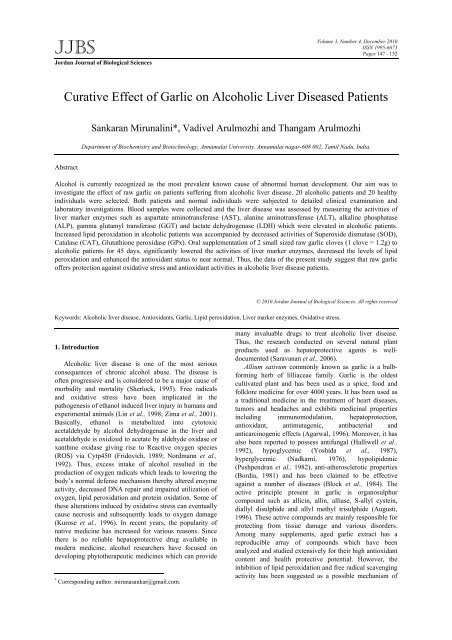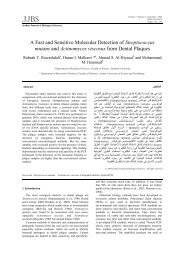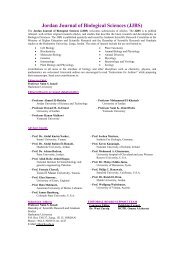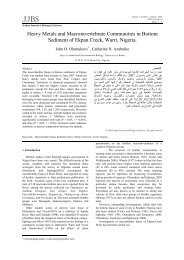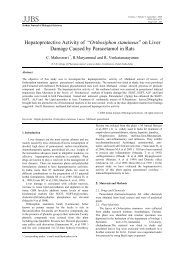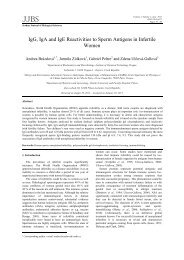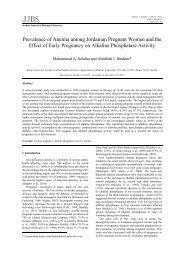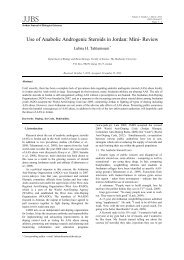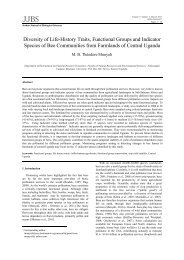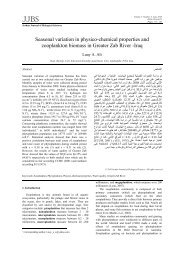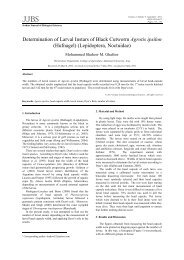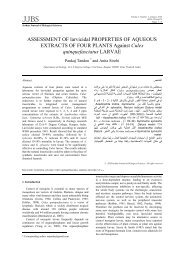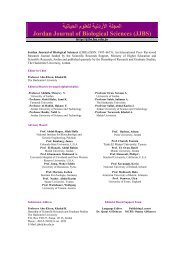Number 4 - Jordan Journal of Biological Sciences
Number 4 - Jordan Journal of Biological Sciences
Number 4 - Jordan Journal of Biological Sciences
Create successful ePaper yourself
Turn your PDF publications into a flip-book with our unique Google optimized e-Paper software.
JJBS<br />
<strong>Jordan</strong> <strong>Journal</strong> <strong>of</strong> <strong>Biological</strong> <strong>Sciences</strong><br />
Volume 3, <strong>Number</strong> 4, December 2010<br />
ISSN 1995-6673<br />
Pages 147 - 152<br />
Curative Effect <strong>of</strong> Garlic on Alcoholic Liver Diseased Patients<br />
Abstract<br />
Sankaran Mirunalini*, Vadivel Arulmozhi and Thangam Arulmozhi<br />
Department <strong>of</strong> Biochemistry and Biotechnology, Annamalai University, Annamalai nagar-608 002, Tamil Nadu, India.<br />
Alcohol is currently recognized as the most prevalent known cause <strong>of</strong> abnormal human development. Our aim was to<br />
investigate the effect <strong>of</strong> raw garlic on patients suffering from alcoholic liver disease. 20 alcoholic patients and 20 healthy<br />
individuals were selected. Both patients and normal individuals were subjected to detailed clinical examination and<br />
laboratory investigations. Blood samples were collected and the liver disease was assessed by measuring the activities <strong>of</strong><br />
liver marker enzymes such as aspartate aminotransferase (AST), alanine aminotransferase (ALT), alkaline phosphatase<br />
(ALP), gamma glutamyl transferase (GGT) and lactate dehydrogenase (LDH) which were elevated in alcoholic patients.<br />
Increased lipid peroxidation in alcoholic patients was accompanied by decreased activities <strong>of</strong> Superoxide dismutase (SOD),<br />
Catalase (CAT), Glutathione peroxidase (GPx). Oral supplementation <strong>of</strong> 2 small sized raw garlic cloves (1 clove = 1.2g) to<br />
alcoholic patients for 45 days, significantly lowered the activities <strong>of</strong> liver marker enzymes, decreased the levels <strong>of</strong> lipid<br />
peroxidation and enhanced the antioxidant status to near normal. Thus, the data <strong>of</strong> the present study suggest that raw garlic<br />
<strong>of</strong>fers protection against oxidative stress and antioxidant activities in alcoholic liver disease patients.<br />
© 2010 <strong>Jordan</strong> <strong>Journal</strong> <strong>of</strong> <strong>Biological</strong> <strong>Sciences</strong>. All rights reserved<br />
Keywords: Alcoholic liver disease, Antioxidants, Garlic, Lipid peroxidation, Liver marker enzymes, Oxidative stress.<br />
1. Introduction *<br />
Alcoholic liver disease is one <strong>of</strong> the most serious<br />
consequences <strong>of</strong> chronic alcohol abuse. The disease is<br />
<strong>of</strong>ten progressive and is considered to be a major cause <strong>of</strong><br />
morbidity and mortality (Sherlock, 1995). Free radicals<br />
and oxidative stress have been implicated in the<br />
pathogenesis <strong>of</strong> ethanol induced liver injury in humans and<br />
experimental animals (Lin et al., 1998; Zima et al., 2001).<br />
Basically, ethanol is metabolized into cytotoxic<br />
acetaldehyde by alcohol dehydrogenase in the liver and<br />
acetaldehyde is oxidized to acetate by aldehyde oxidase or<br />
xanthine oxidase giving rise to Reactive oxygen species<br />
(ROS) via Cytp450 (Fridovich, 1989; Nordmann et al.,<br />
1992). Thus, excess intake <strong>of</strong> alcohol resulted in the<br />
production <strong>of</strong> oxygen radicals which leads to lowering the<br />
body’s normal defense mechanism thereby altered enzyme<br />
activity, decreased DNA repair and impaired utilization <strong>of</strong><br />
oxygen, lipid peroxidation and protein oxidation. Some <strong>of</strong><br />
these alterations induced by oxidative stress can eventually<br />
cause necrosis and subsequently leads to oxygen damage<br />
(Kurose et al., 1996). In recent years, the popularity <strong>of</strong><br />
native medicine has increased for various reasons. Since<br />
there is no reliable hepatoprotective drug available in<br />
modern medicine, alcohol researchers have focused on<br />
developing phytotherapeutic medicines which can provide<br />
* Corresponding author. mirunasankar@gmail.com.<br />
many invaluable drugs to treat alcoholic liver disease.<br />
Thus, the research conducted on several natural plant<br />
products used as hepatoprotective agents is welldocumented<br />
(Saravanan et al., 2006).<br />
Allium sativum commonly known as garlic is a bulbforming<br />
herb <strong>of</strong> lilliaceae family. Garlic is the oldest<br />
cultivated plant and has been used as a spice, food and<br />
folklore medicine for over 4000 years. It has been used as<br />
a traditional medicine in the treatment <strong>of</strong> heart diseases,<br />
tumors and headaches and exhibits medicinal properties<br />
including immunomodulation, hepatoprotection,<br />
antioxidant, antimutagenic, antibacterial and<br />
anticarcinogenic effects (Agarwal, 1996). Moreover, it has<br />
also been reported to possess antifungal (Halliwell et al.,<br />
1992), hypoglycemic (Yoshida et al., 1987),<br />
hyperglycemic (Nadkarni, 1976), hypolipidemic<br />
(Pushpendran et al., 1982), anti-atherosclerotic properties<br />
(Bordia, 1981) and has been claimed to be effective<br />
against a number <strong>of</strong> diseases (Block et al., 1984). The<br />
active principle present in garlic is organosulphur<br />
compound such as allicin, allin, alliase, S-allyl cystein,<br />
diallyl disulphide and allyl methyl trisulphide (Augusti,<br />
1996). These active compounds are mainly responsible for<br />
protecting from tissue damage and various disorders.<br />
Among many supplements, aged garlic extract has a<br />
reproducible array <strong>of</strong> compounds which have been<br />
analyzed and studied extensively for their high antioxidant<br />
content and health protective potential. However, the<br />
inhibition <strong>of</strong> lipid peroxidation and free radical scavenging<br />
activity has been suggested as a possible mechanism <strong>of</strong>


